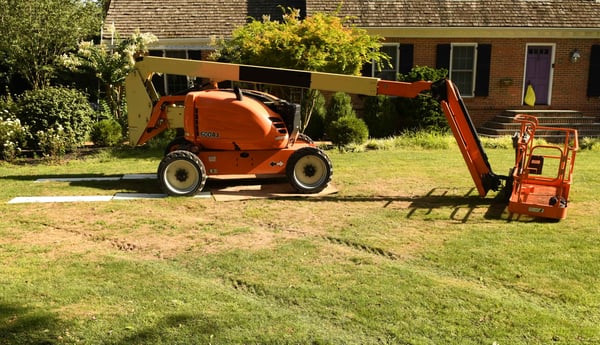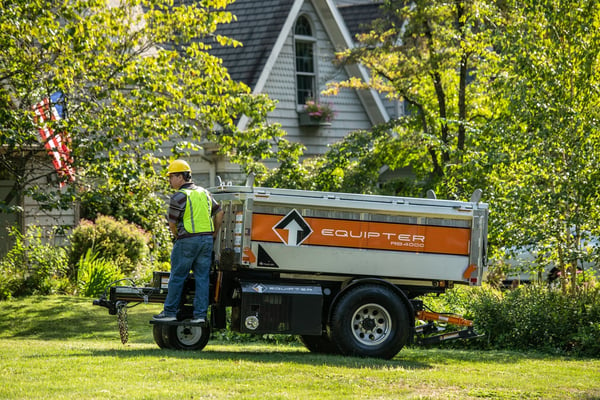How to Fix Grass That Has Been Driven on Easy Way
Roofing Articles
Discover tips and tricks for growing your roofing business efficiently and professionally.
Remember that moment when you realized you just ruined a part of your customer's yard by using heavy equipment that left ruts in their lawn? Lawn and landscape damage, unfortunately, isn't uncommon during roof replacements and construction projects. However, it's something that a professional contractor will want to learn to avoid for several reasons. For one, using large equipment associated with construction and roofing that leaves ruts might mean frustrated homeowners who end up giving your company bad reviews. It also costs you time and money to make the repairs necessary to fix the relationship between you and your customer. Nevertheless, ruts happen. In this article, we'll cover how to fix ruts in a yard and how you can avoid leaving ruts in the future. Ruts are basically soil that's been compacted and needs to be loosened. They need to be fixed differently depending on their size–ruts 1-2 inches deep should be handled differently than ruts of 3-4 inches or deeper. Following are two easy steps for best fixing shallow ruts: To loosen the soil of a shallow rut, find the edge of the rut and push a spade fork into the soil at a 45-degree angle. Since it's 1-2 inches deep, you shouldn't need to dig far. From there, put pressure on the fork handle to lift the soil until it is an inch or two above the turf around it. Eventually, the soil will settle until it's even with the rest of the grass. This should fix a shallow rut most of the time. If this does not fix the problem or if the grass in the rut is damaged, you may need to treat it as a deep rut and follow the next set of instructions. Because there's more damage than a shallow rut, deep ruts (3-4 inches deep or more) are harder to deal with and take more time to fix. Here are the basics for how to fix deep ruts in your customer's yard: If some grass is still intact on the surface of the rut, use a shovel to cut around the edges of the rut and remove the grass. Make sure to include the roots when you remove the grass, so you can easily return the patch of grass after fixing the rut. Take a shovel fork and loosen the soil that's been compacted under the spot the grass was. This can be done in the same way as it's done for a shallow rut (see instructions above). Loosening the soil allows the grass to take root well after being replaced or sown. Since the rut is deep, filling it in with soil will most likely be necessary. For this, you'll want to mix soil with equal amounts of sand or compost. This mixture makes it easier for grass to take root and thrive. After filling in the rut with the soil mixture, replant the grass you dug out if it is still intact. If the grass has been damaged, you'll need to sow new grass seeds. Make sure to use the same seed as what's already been sown in the lawn to ensure there's not a patch of strange-looking grass in your customer's lawn. What if you didn't have to worry about how to fix ruts in your customer's yard on every other job site? Here are some clean-cut tips for avoiding ruts and a damaged reputation. Over time and use, a roll-off dumpster may sink into a yard. Removing a full roll-off dumpster from a customer's lawn will most likely create deep ruts, not just from the dumpster but from the equipment pulling it out as well. This can damage your relationship with a customer, potentially leading to a negative online review for your business and extending the amount of time you're stuck on the job. The solution? Don't place a dumpster on the lawn. Instead, encourage your customer to reserve a space on the driveway or the curbside. Always communicate with your customer before the job begins to determine what works best. Using lightweight equipment ensures that you won't need to spend time worrying about whether or not you'll need to stay after a job to fix ruts in the yard. It'll also improve customer satisfaction, reduce out-of-pocket expenses, and get the job done faster. The Equipter RB4000 does exactly that. This self-propelled dump trailer is lightweight with extra-wide tires that help better distribute the weight in the container, preventing tire ruts in your customers' lawns. The RB4000 streamlines debris management and lifts supplies to where you need them. This saves your workers from the physical stress of double- and triple-handling debris and carrying heavy materials up a ladder. Click the button below to see how else the RB4000 can help your company grow. Still have questions? Give us a call at 717-661-3591 to connect with an Equipter representative today.
Here's how to fix shallow ruts.
1. Loosen the soil.
2. Lift the soil.
Here's how to fix deep ruts in a customer's lawn.
1. Remove grass from the rut.
2. Loosen any compact soil.
3. Fill in the rut with soil.
4. Replace and/or sow grass.
Avoid leaving tire ruts in your customers' lawns
Don't place roll-off dumpsters on the lawn.
Use lightweight equipment.


Always be sure to do your research when investing in or renting equipment. Check out this comparison chart of roofing and construction equipment to choose which type is best for your everyday jobs.
Source: https://www.equipter.com/equipter-articles/how-to-fix-ruts-in-a-yard
0 Response to "How to Fix Grass That Has Been Driven on Easy Way"
Post a Comment